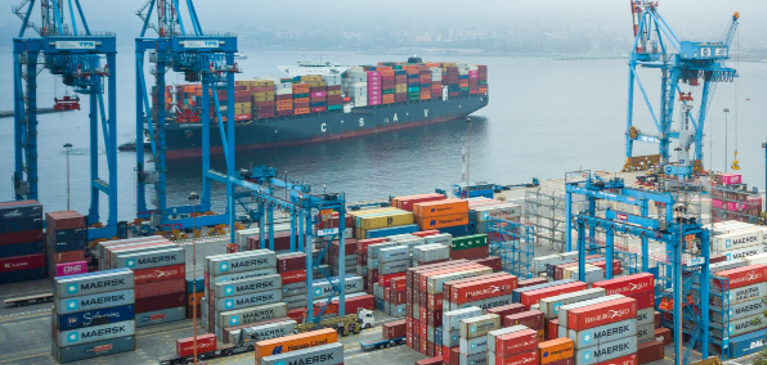
Following the strong economic expansion achieved in the prior year, the U.S. economy has been contending with significant headwinds in 2022. The challenges have most notably come from continued supply chain disruptions, high inflation, and labor shortages.
Making matters worse, the already present inflationary pressures and supply chain bottlenecks have been exacerbated by the ongoing war in Ukraine.
The U.S. economy’s real gross domestic product (GDP) experienced a surprising decline in the first quarter of 2022. According to the U.S. Bureau of Economic Analysis (BEA), GDP decreased at an annual rate of 1.5% through the first three months of the year. This reading marked a stark divergence from GDP’s strong 6.9% annualized growth in the fourth quarter of 2021, and overall 5.7% growth for the full 2021 calendar year. One driver of the decrease in first quarter GDP was the widening trade deficit as U.S. exports fell and imports increased, a result of ongoing supply-chain constraints. Additionally, U.S. businesses reduced their level of inventory investments in the first quarter, as compared to fourth quarter of 2021, which also contributed to the lower growth reading. One bright spot in the BEA’s first quarter report was the increase in consumer spending by an annual rate of 3.1%.
Rising prices across the economy have grabbed headlines and present a potential threat to future economic growth. The U.S. Bureau of Labor Statistics reported the Consumer Price Index (CPI) increased by 1.0% in the month of May and over the past 12 months the CPI has increased by a total of 8.6%. This annualized CPI growth level is the fastest pace of inflation since December 1981. The largest contributors were in the energy index which was up 34.6% year-over-year, and the food/grocery index, up by 11.9% over the past 12 months. While these two categories represent the primary drivers of the rising headline inflation reading, price increases were broad-based across all of the categories tracked in the CPI. Economists have pinned the high rate of inflation on supply chain bottlenecks and remarkably strong consumer demand outpacing supply. These trends have been accelerated, particularly in the energy and food indexes, by the disruptions to global markets from the Russian invasion of Ukraine.
In an attempt to reduce the pace of inflation, the Federal Reserve has launched its most aggressive tightening of monetary policy in over 20 years. At the June 2022 meeting, the Federal Open Market Committee (FOMC) raised interest rates by 0.75%, increasing its target range for the federal funds rate to 1.50% to 1.75%. This was the FOMC’s largest interest rate increase since 1994 and came on the heels of the 0.50% rate increase which was approved at its May 2022 meeting and was the largest since 2000. In addition to raising interest rates, the Federal Reserve announced it will also begin reducing the size of its $9 trillion balance sheet as another tool in its attempt to tamp down inflation. The Fed will allow some of its bond holdings to mature without reinvesting the proceeds. Specifically, the Federal Reserve will not reinvest proceeds from up to $30 billion of Treasury securities, and $17.5 billion of mortgage-backed securities in the months of June, July, and August. Afterwards, it will increase the monthly amount of uninvested proceeds to $60 billion and $35 billion for Treasuries and mortgage securities, respectively. In the end, the Federal Reserve is attempting to achieve a “soft landing” for the U.S. economy, as it attempts to raise interest rates enough to bring down inflation but not too high to cause a recession.
Agricultural commodity prices have been on an increasing trend across the board through the first half of the year. Notably, grain prices have increased significantly since the beginning of 2022 with corn, soybean, and wheat prices up by approximately 30% to 40% year-to-date at the time of this writing. The Russia/Ukraine conflict and its effect on agricultural supply chains has been a major factor in the recent price movements. Other factors driving the rising price environment in global grain markets prior to Russia’s invasion of Ukraine, have been supply reductions due to inventory drawdowns over the past four years and poor weather patterns during growing seasons in South America, combined with strong demand from China and other large importers. The June WASDE report revealed the tight supply/demand situation is likely to continue, especially for corn and soybeans with estimated stocks-to-use ratios for the 2022/2023 marketing year of 10.0% and 4.6%, respectively. In the report, the USDA’s average price forecasts for 2022/2023 were $6.75 per bushel for corn and $14.70 per bushel for soybeans.
Dairy markets have experienced strong price growth throughout 2022 as well, with the Class III milk price up by 32% from the beginning of the year to mid-June. The prices paid to producers have been boosted by higher prices for dairy products, most notably butter and nonfat dry milk, driven by falling inventory levels. Despite the increases in milk prices, milk production has been fractionally lower in 2022 compared to the prior year. Additionally, the U.S. dairy herd is not projected to grow significantly over the next year due to rising expenses from increased feed, labor, and heifer costs. However, U.S. producers are not alone in dealing with increased cost pressures. New Zealand and EU dairy producers are facing similar challenges which has resulted in reduced milk production from these regions as well. With the forecasts for limited supply growth and strong consumer demand for dairy products, the USDA is anticipating milk prices to remain elevated with a 2022 all-milk price forecast of $25.75 per hundredweight.
To view the article in the online 2022 Summer Partners Magazine, click here.


